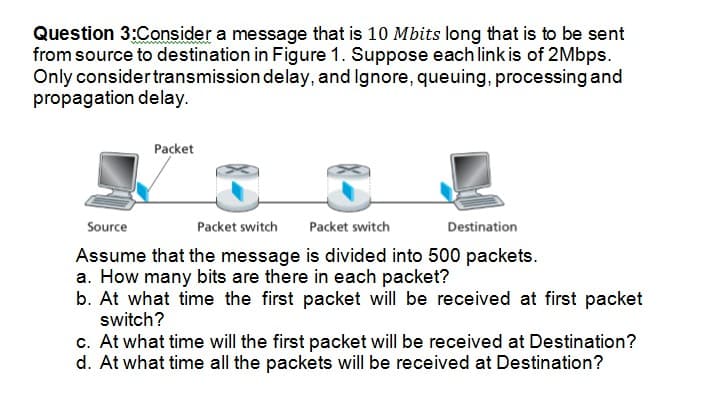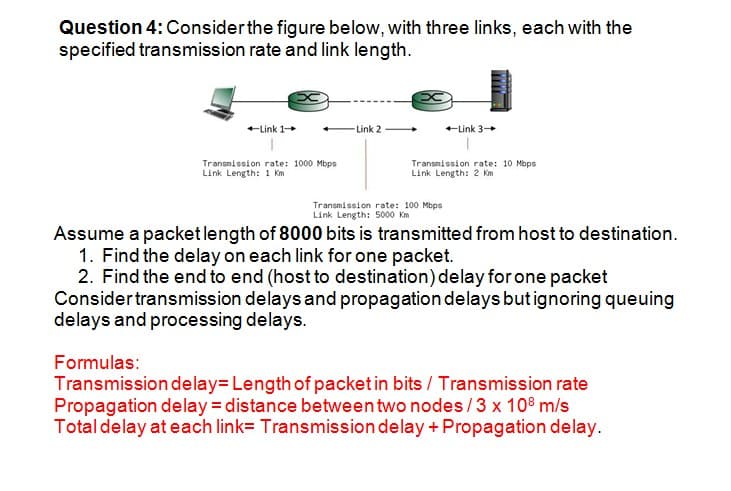Question 3:Consider a message that is 10 Mbits long that is to be sent from source to destination in Figure 1. Suppose each link is of 2Mbps. Only consider transmission delay, and Ignore, queuing, processing and propagation delay. Packet Source Packet switch Packet switch Destination Assume that the message is divided into 500 packets. a. How many bits are there in each packet? b. At what time the first packet will be received at first packet switch? c. At what time will the first packet will be received at Destination? d. At what time all the packets will be received at Destination?
Question 3:Consider a message that is 10 Mbits long that is to be sent from source to destination in Figure 1. Suppose each link is of 2Mbps. Only consider transmission delay, and Ignore, queuing, processing and propagation delay. Packet Source Packet switch Packet switch Destination Assume that the message is divided into 500 packets. a. How many bits are there in each packet? b. At what time the first packet will be received at first packet switch? c. At what time will the first packet will be received at Destination? d. At what time all the packets will be received at Destination?
Computer Networking: A Top-Down Approach (7th Edition)
7th Edition
ISBN:9780133594140
Author:James Kurose, Keith Ross
Publisher:James Kurose, Keith Ross
Chapter1: Computer Networks And The Internet
Section: Chapter Questions
Problem R1RQ: What is the difference between a host and an end system? List several different types of end...
Related questions
Question

Transcribed Image Text:Question 3:Consider a message that is 10 Mbits long that is to be sent
from source to destination in Figure 1. Suppose each link is of 2Mbps.
Only considertransmission delay, and Ignore, queuing, processing and
propagation delay.
Packet
Source
Packet switch
Packet switch
Destination
Assume that the message is divided into 500 packets.
a. How many bits are there in each packet?
b. At what time the first packet will be received at first packet
switch?
c. At what time will the first packet will be received at Destination?
d. At what time all the packets will be received at Destination?

Transcribed Image Text:Question 4: Considerthe figure below, with three links, each with the
specified transmission rate and link length.
+Link 1
Link 2
+Link 3+
Transmission rate: 1000 Mbps
Link Length: 1 Km
Transmission rate: 10 Mbps
Link Length: 2 Km
Transmission rate: 100 Mbps
Link Length: 5000 Km
Assume a packetlength of 8000 bits is transmitted from host to destination.
1. Find the delay on each link for one packet.
2. Find the end to end (host to destination) delay for one packet
Considertransmission delays and propagation delays but ignoring queuing
delays and processing delays.
Formulas:
Transmission delay= Length of packet in bits / Transmission rate
Propagation delay = distance between two nodes/3 x 108 m/s
Total delay at each link= Transmission delay + Propagation delay.
Expert Solution
This question has been solved!
Explore an expertly crafted, step-by-step solution for a thorough understanding of key concepts.
This is a popular solution!
Trending now
This is a popular solution!
Step by step
Solved in 5 steps

Recommended textbooks for you

Computer Networking: A Top-Down Approach (7th Edi…
Computer Engineering
ISBN:
9780133594140
Author:
James Kurose, Keith Ross
Publisher:
PEARSON

Computer Organization and Design MIPS Edition, Fi…
Computer Engineering
ISBN:
9780124077263
Author:
David A. Patterson, John L. Hennessy
Publisher:
Elsevier Science

Network+ Guide to Networks (MindTap Course List)
Computer Engineering
ISBN:
9781337569330
Author:
Jill West, Tamara Dean, Jean Andrews
Publisher:
Cengage Learning

Computer Networking: A Top-Down Approach (7th Edi…
Computer Engineering
ISBN:
9780133594140
Author:
James Kurose, Keith Ross
Publisher:
PEARSON

Computer Organization and Design MIPS Edition, Fi…
Computer Engineering
ISBN:
9780124077263
Author:
David A. Patterson, John L. Hennessy
Publisher:
Elsevier Science

Network+ Guide to Networks (MindTap Course List)
Computer Engineering
ISBN:
9781337569330
Author:
Jill West, Tamara Dean, Jean Andrews
Publisher:
Cengage Learning

Concepts of Database Management
Computer Engineering
ISBN:
9781337093422
Author:
Joy L. Starks, Philip J. Pratt, Mary Z. Last
Publisher:
Cengage Learning

Prelude to Programming
Computer Engineering
ISBN:
9780133750423
Author:
VENIT, Stewart
Publisher:
Pearson Education

Sc Business Data Communications and Networking, T…
Computer Engineering
ISBN:
9781119368830
Author:
FITZGERALD
Publisher:
WILEY